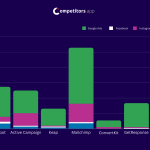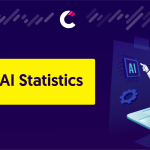Competition Monitoring has plenty of use cases. Indeed, it can help you to improve user onboarding and attract more customers.
Do you know that competitors’ are the core of every business? And that carefully conducting your competitors’ research is going to save your business from doom?
Me neither, until I failed when I started my first startup. The reason why we failed is that we didn’t pay too much attention to our competitors. We just thought:
“Okay, we have this feature, this feature and this feature. All of them are amazing! The customers would love them!”
The truth is: nope. They didn’t love them. They didn’t even use our product. Why?
Our competitors were some 20-year old companies from the IT sector. Their websites were awful. But still, they managed to provide enough value to their users.
We have just overwhelmed existing and useful products. It turned out that our potential customers liked simplicity.
We didn’t realize that our competitors’ are big gamers in our industry. We have just thought: “Nah, they have a crappy website. They are useless.”
That thinking cost us our time and money.
My dear friends, that’s the reason why I have decided to show you what I have learned afterward, what were my mistakes, and how can you implement some of the tactics.
In this article, we will cover everything from doing great competitive research, over recapturing competitors’ users to successfully onboarding them, and creating in-app experiences suitable for them.
Let’s dive in!
Easiest, Fastest and Most Efficient way to Conduct your Competitors’ Research
We all hate conducting competitive research.
Yea, I will admit it – I hate it too!
But the point is – we need to do this in the best way we can if we want to build a profitable and enduring business.
So, here is how to do it in several steps (Yea, it will still cost you some time, but in the worst, you will invest no more than 5 hours for this – instead of 10+ like we all used before):
1. Write down several most relevant keywords for your business, product, service or feature (10 minutes)
2. Type all of them in Google and write down the first eight links on the page for every particular keyword. (20 minutes)
3. Filter those links to find out who is your competitor and who isn’t. (20 minutes)
4. Create an insightful and detailed spreadsheet, where you can put as much information as you can. Here is some necessary information you should look for:
– Name of the company
– Headquarters, Address, State
– Founders
– Resources (Team size, investments, founders previous experience, etc.) Everything which can help you to determine their power and ability to create and make changes faster.
– Product features
– Unique Value Propositions
– Distribution and User Acquisition channels (Social Networks, Quora, Reddit, Pinterest, etc.)
– Unique Buying Persona and Target Audience
– Technical information (Languages used to build the product, Website information – Traffic, Domain Authority, Trust Factor, Citation Flow, Spam Score, etc.)
(20 minutes)
5. Find this data (30 minutes to 1 hour per competitor).
And that’s it! You will have a perfect Competitive Research in a few hours!
Now it’s time to see what can we do with this data. We can’t just put it in some forgotten or hidden folder. Right?
How to use your Competitive Research Data in your Advantage?
So, how can great competitive research help us to improve and expand our business?
From all the information you found above, you can see a lot of useful things about some of your competitors you can use in crafting and executing significant competitive advantages and to improve user onboarding:
- Knowing your competitor’s available resources (time size, investment, etc.) will help you to determine what are their strengths and how fast they can implement changes, new trends, and pivoting.
- Having clear insights into their Unique Value propositions and key features will help you to understand their offerings and what’s their trigger when acquiring new customers
- Their founders must become your best friends – following their founders on all possible social media and rewatching or re-reading their old interviews will help you to see through what challenges they passed and how they solved some particular problems.
- Have clear insights into their marketing channels – understanding this will help you to find out and determine their best acquisition and distribution channels. Understanding how are they onboarding their new customers is crucial if you want to beat them.
Now when we saw how can some particular data from Competitive Research help us, it’s time to see how can we create converting onboarding tactics.
Customers are bosses
There is no business that will live without its’ customers. It’s the same for your competitors and the same for you too. Whether you are in a big or small market, sometimes it’s not just enough to fight for, let’s say, 2% market share.
Sometimes we need to acquire a much more significant share if we want to build an enduring business and create a monopoly.
Having a clear mindset here is crucial, so ask yourself this:
“What would happen if I recapture some of my competitors’ customers?”
Yea, you read it right.
When you succeed in recapturing some of your competitors’ customers, in the long run, you will not recover just a few of them. You will recapture much more.
The key thing here is to offer some new key features, value propositions, or even to personalize your onboarding experience.
The best way to test your product, features and unique value proposition is actually to talk to your competitors’ customers! 🙂
Create some little surveys or even conduct some 15-minute call or video interviews. Because they are charming people (who else would give you 15 minute of their time in this busy world. right?), you can offer them some extended trial, discount, or your exclusive learning material.
The goal of your competitors’ customer development is to:
- Understand their most significant pain about problems that you and your competitors are solving.
- Realizing what’s important for them.
- Creating better competitive advantages and onboarding methodologies based on your competitors’ customer development.
Education is the key
There is no better way to improve user onboarding than educating your competitors’ customers better.
Find the gaps in your competitors’ products and onboarding method, and improve them! Let’s take the following example:
There is a lot of Project Management tools right there. We have Asana, Trello, Atlassian, and many more of them, and almost all of them are complicated. The best software out there is the one that provides the best education and onboarding methodologies for its customers.
When some customer is changing one tool and going to another one, the biggest problem he has is the transformation itself.
Use the data from your researches and make sure that your product, onboarding strategies, and educational material are filling the gaps.
Create unique explaining videos. For example, you, as a CEO, can speak and explain your potential customers how can they use the tool or what are the benefits of using your tool instead of your competitors’ tools.
Pro Tip: put your face whenever you can – it will help you to establish better relationships with your customers and improve your personal and company brand.
Track Competitors’ Transactional Emails
Transactional (or drip) emails are triggered and behavioral-based emails.
According to Experian, transactional emails receive eight times bigger open rates than any other type of marketing emails.
Sending transactional emails will undoubtedly help you to improve user onboarding.
What are some transactional email examples?
– Welcome emails – emails that are sent whenever someone creates an account
– Triggered transactional emails – your user just activated your most important feature? Send him the tips and tricks about that particular feature through email!
– Activity-based transactional emails – Your user isn’t seen for a while? Remind them of the benefits of using your product
– The trial is ending – Whenever your user’s trial is about to end, remind them through transactional email.
There are countless examples of using transactional emails to improve user onboarding.
Here are some examples of how we at Competitors App use transactional emails to improve the activation rate.

Whenever we see that someone didn’t add it’s domain, we trigger them this email.
This particular email generated over 50% open rate, and more than 30% of those who opened this email added their domain.

Here, we’re offering our trial customers dedicating help and support by asking them to schedule 1 on one meeting with us.
This particular email generated more than 43% open rates and more than 25% of people who opened it scheduled the meeting.
Do you see the power of transactional emails?
Now, how can you get the most out of your competitors’ transactional emails?
Your competitors invested a lot of time and money to craft amazing transactional email campaigns or copies. They probably know better than you what’s working and what’s not.
So, why do you need to reinvent the wheel?
When you’re adding new competitors in your Competitors.app account, you will see the following notification at the bottom:

If you want to track and keep an eye on your competitors’ transactional emails, create a trial account with the [email protected] email address.
For example, if you want to monitor HubSpot, it may look like this:

Afterward, you can check your competitors’ transactional emails in your Competitors App dashboard.
Now you’re ready for skyrocketing your transactional email open rates!
Improve user onboarding with better in-app experiences
Is your goal to make better user onboarding? Right?
By now, you know your competitors very well; you know their strengths, weaknesses, unique features, and user activation events. You know what their customer’s pain points are, and how are they activating their trial users through transactional emails.
There are two last steps you need to conduct if you want to improve user onboarding flow, improve your retention, reduce churn, and activate more users:
- Check their in-app user onboarding
- Improve user onboarding
The best way to check your competitors’ in-app user onboarding is actually to try their product.
Signup to them, and see what are they doing.
How does their user onboarding flow look like? Do they use checklists, product tours, or progress bars? What are their tooltips?
Check whatever you can and write it down.
If you’re “lucky” and your competitors are well-established businesses, try to search for their user onboarding teardowns on the web.
Like this one, for example:

The next step is to improve user onboarding flows and make them better than your competitors have.
You can always use your dev resources or open libraries to create amazing in-app experiences, UX, and UI elements.
But, you can also use user onboarding software to accomplish that.
For example, User pilot is one of the Walkme and Appcues alternatives. It helps you to build triggered and behavioral-based user onboarding elements and in-app experiences.
The Bottom Line
As far as we have seen, you can achieve great results with constant competition monitoring. There are various use cases, and how to improve user onboarding based on your competitors’ research and competition monitoring is undoubtedly one of them.
If you want to know more about how Competitors’ App can help you to create competitive advantages, you can check our features or signup for free!
![Improve User Onboarding by Monitoring your Competitors [Actionable Guide]](https://competitors.app/wp-content/uploads/2019/05/CompetitorsAppaddyourdomaintransactionalemail_800e5a102f94a7ac57feca874ec45ae8_2000.png)







